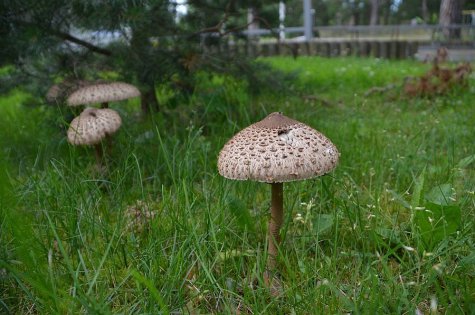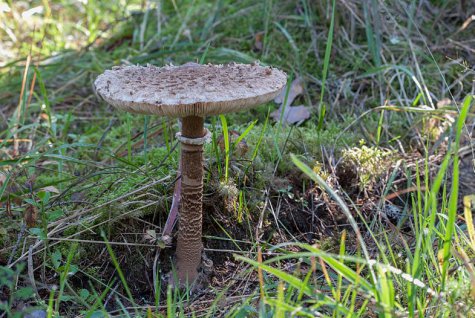About delectable and not so delectable parasol mushrooms
Photo Kaido Einama
Translation Liis
Parasol mushroom; Large parasol mushroom Suur-sirmik Macrolepiota procera
In Võsu in Lääne-Viru county very special parasol mushrooms, with respect to looks as well as taste, were picked last weekend. Habitats grassy forest verges with sandy soil, occasionally actually on the beach itself.
The cap of a young parasol mushroom is egg-shaped, then like a bell, as fully grown broadly flattened. The diameter may reach 30 centimetres. The surface of the cap is covered by large dark brown scales from the cap skin, on a paler background. The gills on the underside of the cap are white and fragile. The stem is long with a dark brown cross-wise banded pattern and at the top part of the stem is a large loose ring.
A delicacy freshly fried (dip in egg and flour before frying). The flesh is soft and like cotton wool, smells and tastes a little nutty, but this depends on the taster. Put only the caps in the frying pan. Since it often grows in groups, a nice meal can be picked even for a large party. It can also be dried to be added as mushroom flour to mushroom dishes and sauces in winter.
The mushroom pickers at Võsu examined the differences between the parasol mushroom and the shaggy parasol.
Photo Arne Ader
Shaggy cap
So, the shaggy cap, extremely similar to the parasol mushroom, has twosubspecies.
Shaggy cap Safransirmik Macrolepiota rhacodes
Shaggy cap, garden variety Safransirmiku aedteisend Macrolepiota rhacodes var. bohemica
As for taste almost comparable with the parasol mushroom. A parasol found among Oxalis is almost certainly a shaggy parasol. If the shaggy parasol's stem is cut off or the gills are damaged, or cuts are made in the cap the damaged spot changes to saffron reddish within seconds.
The stem of the shaggy cap is uniformly coloured. The stem of the parasol mushroom is longer and patterned, and a damaged spot does not become discoloured.
Now about the garden variety of the shaggy cap, CONDITIONALLY INEDIBLE.
Firstly – it does not grow in forests. It is most frequently found in home gardens. When the cap of the garden variety is injured the damaged spot becomes saffron-reddish only after some minutes, not at once as with the shaggy cap proper.
There is one more rather similar parasol mushroom:
Freckled dappling Püramiid-soomussirmik Echinoderma aspera
The cap of this mushroom is smaller. It is basically a poisonous mushroom, with a rank and unpleasant smell. We can find it growing in gardens, and sometimes in forests with a fertile soil. Leave it growing there!










